Sturm Graz currently sit in second place in the Austrian Bundesliga, 4 points off league leaders RB Salzburg in the closing stages of the season with a final in the OFB Cup on the horizon. Sturm Graz have displayed their excellent qualities to the whole of Europe, after an unforgettable UEFA Europa League group stage, with fellow group members Feyenoord, Lazio and Midtjylland all finishing on an equal number of points, only separated by goal difference.
From set-pieces, Sturm Graz have been able to create many goalscoring chances, but a lack of consistency in the accuracy of crosses has prevented them from being a consistent threat from dead balls. They have only scored goals in 4 separate games from corners, but the goals have been decisive and a key reason why they are on course for a UEFA Champions League spot.
In this tactical analysis, we will look into the tactics used by Sturm Graz, with an in-depth analysis of how they have been able to use several different routines to create high-quality chances in their variations of corners. This set-piece analysis will look at the reasons behind the different routines used and how the specific use of decoy runners has been extremely effective.
Near post routines
Die Schwoazn have attempted to make the most of the open space at the edge of the six-yard box, from where they can either redirect the ball goal wards or flick the ball towards the back post for a second phase opportunity. The target area (pictured in black below) has been targeted in numerous ways, which will be detailed below.
Firstly, the most direct method of getting the ball into the target area has been utilised when no zonal markers protect the near side of the six-yard box. In these scenarios, teams usually have a number of man markers, with the task of tracking any potential runners who attempt to get in front of the deeper zonal markers. In such cases, Sturm Graz have used players attacking the ball from the blind side of the man markers, which usually means having the attacker start inside the goal.
When an attacker starts inside the goal, it becomes extremely difficult for a defender to have both the ball and the player in their view, unless they start behind them. If the defender does have both in his line of view, it would mean they aren’t able to be goalside and so it becomes easy for the attacker to get the separation from the defender by sprinting away into the space, or for the ball to simply directly be crossed into the attacker.
In instances like the one pictured below, where the defender is blocking the direct cross, it means the defender has to scan in order to know the attacker’s position. As a result, during the defender’s scans when he rotates his head, the attacker is able to stay in his blind spot and create separation to attack the target area.
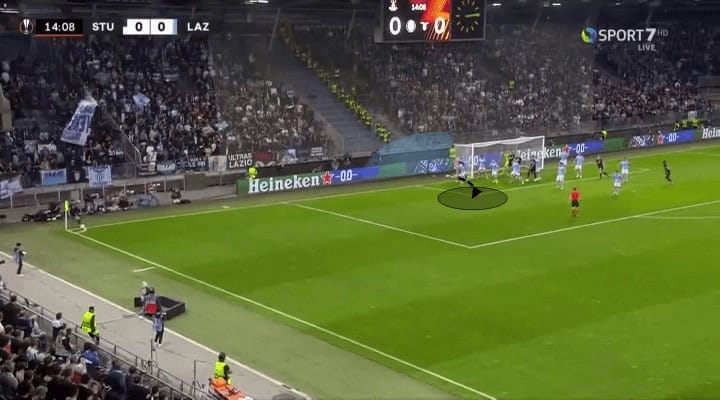
In most corners, defending teams set up with a zonal marker to prevent the direct cross into the available space. Sturm Graz have utilised a number of methods to create space in the target zone described earlier. One way in which this has been made possible has been through the use of a decoy run, dragging the zonal marker away from his original position. An early run (blue line) is made before the corner is taken, which the nearest zonal marker has to follow, in case the corner is aimed for the blue player, who can then flick the ball but from a tighter angle which can lead to a dangerous second phase.
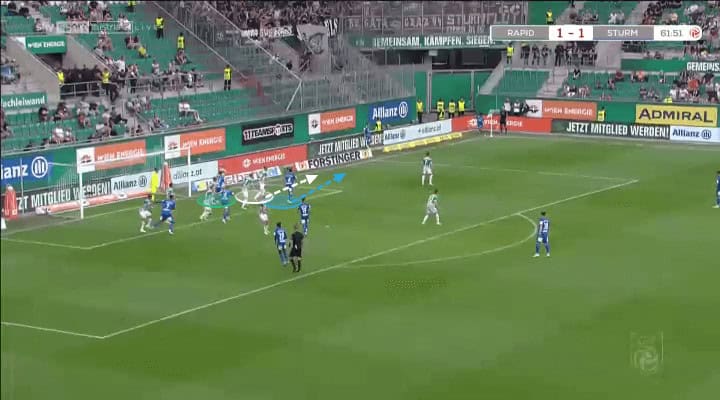
We can see below, once the zonal marker vacates his original position, the actual target (green) is able to attack the space that has just opened up from where they have the choice again of either a shot on goal or flick across the six-yard box. Coming in from the defender’s blind spot again means that he can arrive unopposed, whilst the other zonal markers can only jump from a static position, giving the attacker the advantage in the aerial duel.
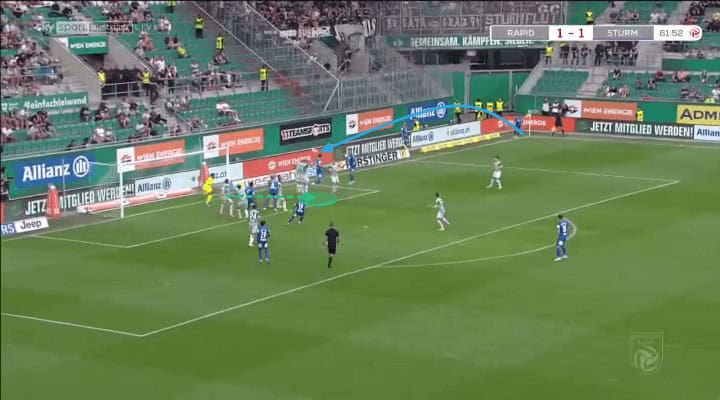
Below is another example of the decoy run being utilised to create space on the near side of the six-yard box. The green attacker is pictured with no defenders near him after the zonal marker has been dragged away again by the player in blue. This time around, Sturm Graz have also prepared a back post runner to be able to attack the ball if it gets headed across the face of the goal.
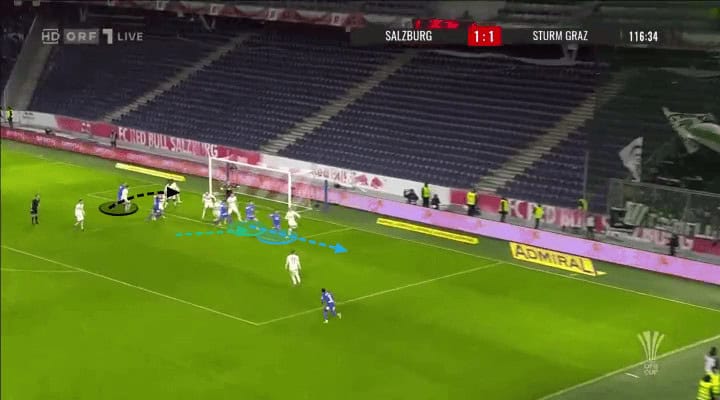
Flicking the ball towards the back post can lead to more dangerous occasions in the second phase. As the ball is headed by the first player, defenders begin to ball-watch, becoming rooted to their spots as their eyes watch the ball. It then becomes simpler for the remaining attackers to lose their markers, and arrive in dangerous areas unopposed. The diagram below illustrates the defender’s view fixated on the ball, whilst the attackers move around the back to arrive at the back post unmarked.
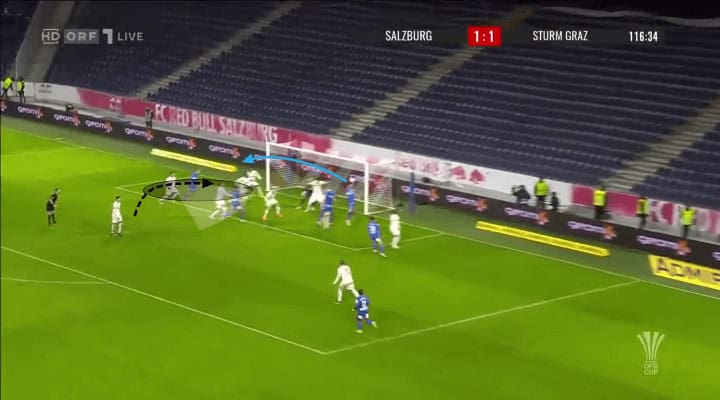
One final way in which Sturm Graz have arrived in the target area, is through runs from deep where the attacker can arrive unmarked. The picture below shows the use of a decoy run yet again (white), whilst the target player (green) arcs around from the back post into the target area. Making the run into the target area from across the six-yard box can be effective, as the horizontal movement means that the intended target (green) begins next to a zonal marker, so when he moves away, no one is responsible for marking that attacker.
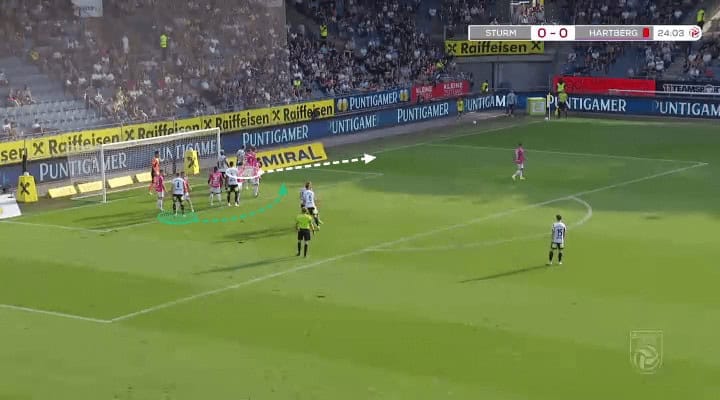
Sturm Graz have also utilised a screen on the goalkeeper, in order to prevent the goalkeeper from being able to claim the cross. The blue and green marks show the decoy runs Sturm Graz that have used consistently. The player in red steps across the goalkeeper to force him to stay on the goal line, and make the delivery less likely to be intercepted. If the defending team has a player on the line, the block on the goalkeeper can also be used to get into the keeper’s line of sight, to make it tougher for him to see the ball and react to the shot.

Using the near post as a decoy
As the season has progressed, teams have become warier of the near post threat, which has made them use a larger number of defensive players around the near side of the six-yard box. As a result, teams have allowed the back side of the six-yard box to become more vulnerable. One way in which Sturm Graz have used the near side as a decoy is through the over-exaggeration of the near post runners, which has allowed the back post to be unmarked.
The arrows below display the runs being made towards the near post, whilst the player furthest from the goal seems uninterested before attacking the back post.

We can see every defender being dragged away from the back post, which leaves space in the back side of the six-yard box for the deep player to attack. The large space around the back post allows for the attacker to attack the ball with the choice of either his foot or head, with the opportunity to volley an effort on goal from within six yards being extremely difficult to stop.
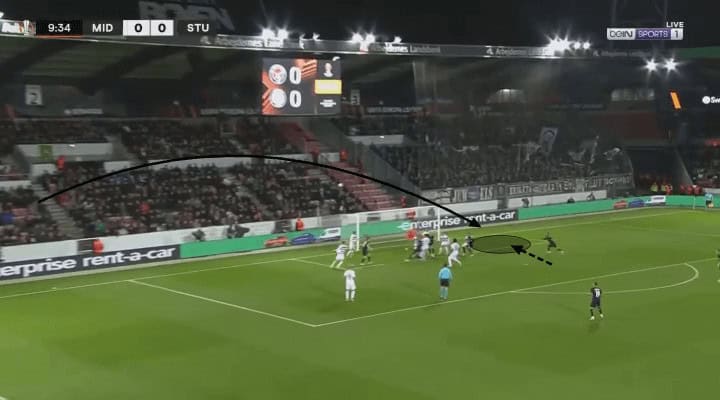
Sturm Graz have also utilised floated crosses towards the back post to create opportunities in the second phase. The near-post decoy runs again have dragged players away from the far post, which gives Sturm Graz access to the far side of the six-yard box. The floated cross is easier to track for attacking players due to the slower flight of the ball, although it is also trickier to put power on the headed effort. Crossing the ball to the far side of the area also makes it difficult for the goalkeeper to claim the ball, due to how far away the ball is landing from the goal.
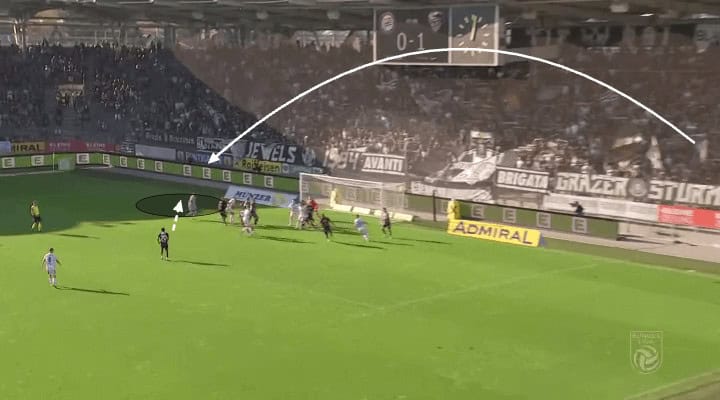
Once the ball reaches the far post, it is then headed back across the face of the goal. Creating a second ball opportunity allows for the remaining attackers to arrive in dangerous positions unmarked, as the defenders fixate their eyes on the ball as mentioned earlier. We can see in the image below, three separate attackers attacking the six-yard box, arriving in the area unmarked all ready to attack the second ball.
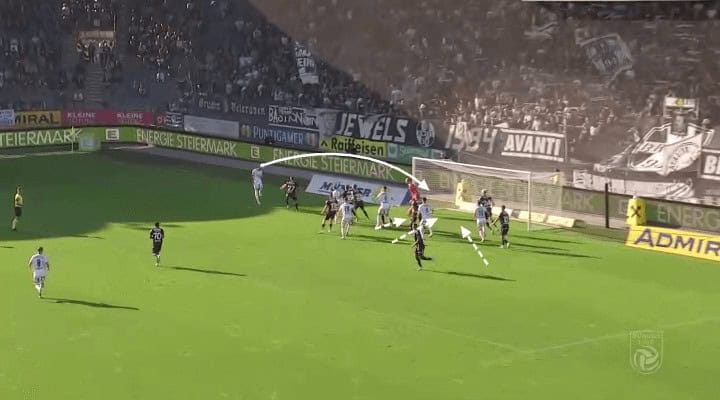
Conclusion
This tactical analysis has detailed the different ways Sturm Graz have made a name for themselves as a threat from near post corners.
They have a clear preference to attack the near edge of the six-yard box, with their immense threat in that area providing a vast amount of space around other areas inside the six-yard box.
These corners have proven to be a good method of chance creation for the side challenging the top of the Austrian Bundesliga, although a lack of consistent corner deliveries means they can’t be threatening each game.






Comments